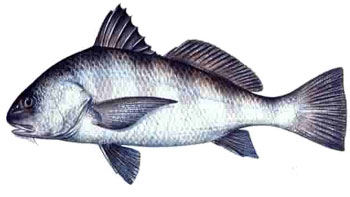
Pogonias cromis
Drum, Striped Drum
The Black Drum has a short, deep, and stocky body with a high arched back and a slightly concave tail. The lower jaw sports numerous barbels, or short whiskers. There are large pavement-like teeth in the throat, and the mouth is low. The dorsal fins have 11 spines, 20 to 22 dorsal rays, and 41 to 45 scales along the lateral line, which runs all the way to the end of the tail. There are 14 to 16 gill rakers on the lower limb of the first arch. Its coloring is silvery with a brassy sheen and blackish fins, turning to dark gray after death. Juveniles have four or five broad, dark, vertical bars on the body. The common term "drum" refers to the loud and distinctive "drumming" noise that occurs when the fish raps a muscle against the swim bladder. The noise is voluntary and is assumed to be associated with locating and attracting mates, and it can sometimes be heard from a good distance, even by people above the water.
Black Drums feed on fishes, crustaceans, and oysters, which they crush with their huge pharyngeal teeth.
From Gulf of Maine to South Florida; Gulf of Mexico west from South Florida to Laguna Madre, Mexico; Brazil.
The preferred habitat is coastal waters including bays, sounds, and inlets where salinities range from near fresh to sea strength. They are commonly found near bridges, piers and other manmade structures.
The average size of the Black Drum is 30 to 50 pounds but they have been caught at over 100 pounds.
113 pounds, 1 ounce (IGFA)